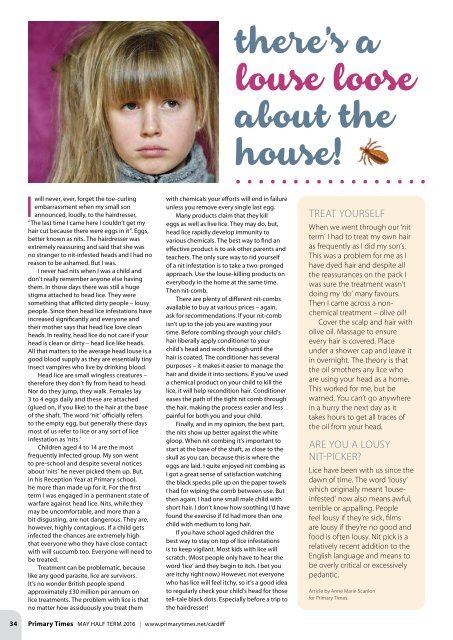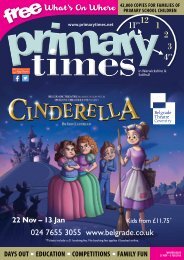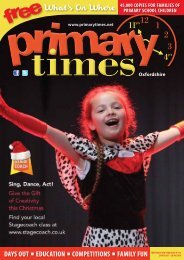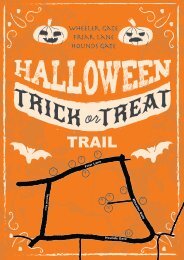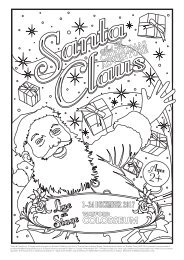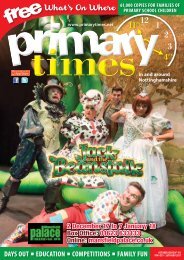Create successful ePaper yourself
Turn your PDF publications into a flip-book with our unique Google optimized e-Paper software.
there’s a<br />
louse loose<br />
about the<br />
house!<br />
Iwill never, ever, <strong>for</strong>get the toe-curling<br />
embarrassment when my small son<br />
announced, loudly, to the hairdresser,<br />
“The last time I came here I couldn’t get my<br />
hair cut because there were eggs in it”. Eggs,<br />
better known as nits. The hairdresser was<br />
extremely reassuring and said that she was<br />
no stranger to nit-infested heads and I had no<br />
reason to be ashamed. But I was.<br />
I never had nits when I was a child and<br />
don’t really remember anyone else having<br />
them. In those days there was still a huge<br />
stigma attached to head lice. They were<br />
something that afflicted dirty people – lousy<br />
people. Since then head lice infestations have<br />
increased significantly and everyone and<br />
their mother says that head lice love clean<br />
heads. In reality, head lice do not care if your<br />
head is clean or dirty – head lice like heads.<br />
All that matters to the average head louse is a<br />
good blood supply as they are essentially tiny<br />
insect vampires who live by drinking blood.<br />
Head lice are small wingless creatures –<br />
there<strong>for</strong>e they don’t fly from head to head.<br />
Nor do they jump, they walk. Females lay<br />
3 to 4 eggs daily and these are attached<br />
(glued on, if you like) to the hair at the base<br />
of the shaft. The word ‘nit’ officially refers<br />
to the empty egg, but generally these days<br />
most of us refer to lice or any sort of lice<br />
infestation as ‘nits.’<br />
Children aged 4 to 14 are the most<br />
frequently infected group. My son went<br />
to pre-school and despite several notices<br />
about ‘nits’ he never picked them up. But,<br />
in his Reception Year at Primary school,<br />
he more than made up <strong>for</strong> it. For the first<br />
term I was engaged in a permanent state of<br />
warfare against head lice. Nits, while they<br />
may be uncom<strong>for</strong>table, and more than a<br />
bit disgusting, are not dangerous. They are,<br />
however, highly contagious. If a child gets<br />
infected the chances are extremely high<br />
that everyone who they have close contact<br />
with will succumb too. Everyone will need to<br />
be treated.<br />
Treatment can be problematic, because<br />
like any good parasite, lice are survivors.<br />
It’s no wonder British people spend<br />
approximately £30 million per annum on<br />
lice treatments. The problem with lice is that<br />
no matter how assiduously you treat them<br />
with chemicals your ef<strong>for</strong>ts will end in failure<br />
unless you remove every single last egg.<br />
Many products claim that they kill<br />
eggs as well as live lice. They may do, but,<br />
head lice rapidly develop immunity to<br />
various chemicals. The best way to find an<br />
effective product is to ask other parents and<br />
teachers. The only sure way to rid yourself<br />
of a nit infestation is to take a two-pronged<br />
approach. Use the louse-killing products on<br />
everybody in the home at the same time.<br />
Then nit-comb.<br />
There are plenty of different nit-combs<br />
available to buy at various prices – again,<br />
ask <strong>for</strong> recommendations. If your nit-comb<br />
isn’t up to the job you are wasting your<br />
time. Be<strong>for</strong>e combing through your child’s<br />
hair liberally apply conditioner to your<br />
child’s head and work through until the<br />
hair is coated. The conditioner has several<br />
purposes – it makes it easier to manage the<br />
hair and divide it into sections. If you’ve used<br />
a chemical product on your child to kill the<br />
lice, it will help recondition hair. Conditioner<br />
eases the path of the tight nit comb through<br />
the hair, making the process easier and less<br />
painful <strong>for</strong> both you and your child.<br />
Finally, and in my opinion, the best part,<br />
the nits show up better against the white<br />
gloop. When nit combing it’s important to<br />
start at the base of the shaft, as close to the<br />
skull as you can, because this is where the<br />
eggs are laid. I quite enjoyed nit combing as<br />
I got a great sense of satisfaction watching<br />
the black specks pile up on the paper towels<br />
I had <strong>for</strong> wiping the comb between use. But<br />
then again, I had one small male child with<br />
short hair. I don’t know how soothing I’d have<br />
found the exercise if I’d had more than one<br />
child with medium to long hair.<br />
If you have school aged children the<br />
best way to stay on top of lice infestations<br />
is to keep vigilant. Most kids with lice will<br />
scratch. (Most people only have to hear the<br />
word ‘lice’ and they begin to itch. I bet you<br />
are itchy right now.) However, not everyone<br />
who has lice will feel itchy, so it’s a good idea<br />
to regularly check your child’s head <strong>for</strong> those<br />
tell-tale black dots. Especially be<strong>for</strong>e a trip to<br />
the hairdresser!<br />
treat yourself<br />
When we went through our ‘nit<br />
term’ I had to treat my own hair<br />
as frequently as I did my son’s.<br />
This was a problem <strong>for</strong> me as I<br />
have dyed hair and despite all<br />
the reassurances on the pack I<br />
was sure the treatment wasn’t<br />
doing my ‘do’ many favours.<br />
Then I came across a nonchemical<br />
treatment – olive oil!<br />
Cover the scalp and hair with<br />
olive oil. Massage to ensure<br />
every hair is covered. Place<br />
under a shower cap and leave it<br />
in overnight. The theory is that<br />
the oil smothers any lice who<br />
are using your head as a home.<br />
This worked <strong>for</strong> me, but be<br />
warned. You can’t go anywhere<br />
in a hurry the next day as it<br />
takes hours to get all traces of<br />
the oil from your head.<br />
are you a lousy<br />
nit-picker?<br />
Lice have been with us since the<br />
dawn of time. The word ‘lousy’<br />
which originally meant ‘louseinfested’<br />
now also means awful,<br />
terrible or appalling. People<br />
feel lousy if they’re sick, films<br />
are lousy if they’re no good and<br />
food is often lousy. Nit pick is a<br />
relatively recent addition to the<br />
English language and means to<br />
be overly critical or excessively<br />
pedantic.<br />
Article by Anne Marie Scanlon<br />
<strong>for</strong> Primary Times.<br />
34<br />
Primary Times may half term <strong>2016</strong> | www.primarytimes.net/cardiff


